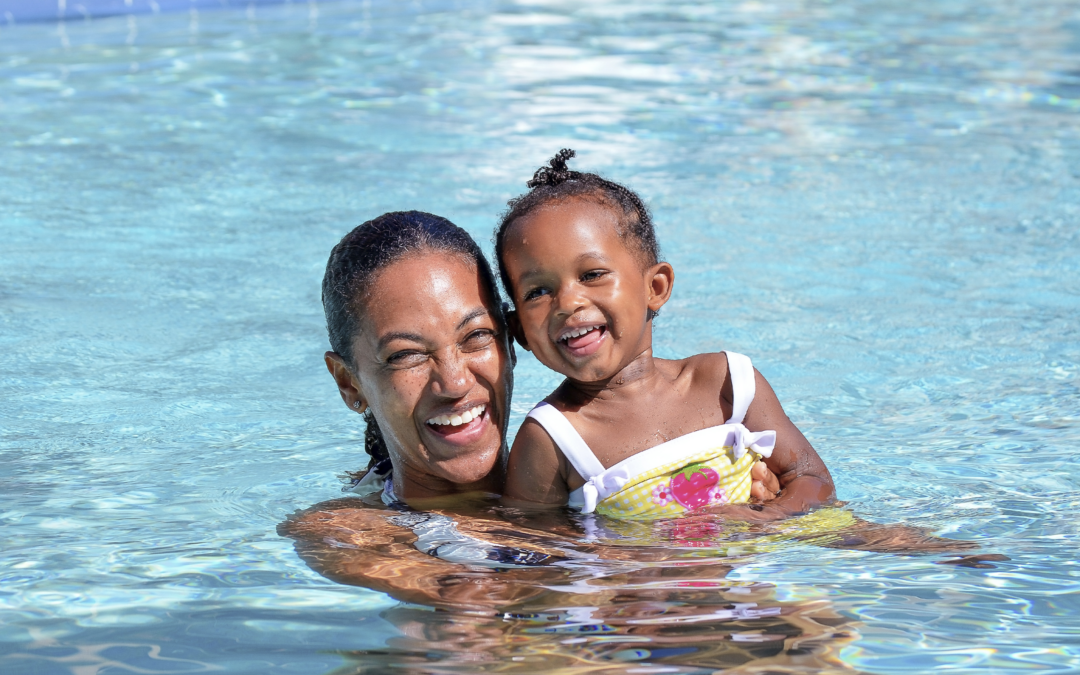Nothing beats the heat quite like a refreshing dip in the pool! Before you let your kids dive in, though, make note of these swim safety tips.
Drowning is the leading cause of accidental deaths for children aged 1-4, and the second leading cause for children 5+ years old. It is so important to keep your kids safe in and around water. If a child is missing, check the pool/water first. Seconds count and looking in the water first may save a life!
Here are some expert tips on preparing you and your kids for having a safe and fun summer!
Swim Safety Tips for Kids
#1: Always Watch Kids When They Are Swimming
- Make sure there is an adult who can swim assigned to watch your children at all times.
- Make sure they know they are responsible for watching the kids. Never assume; talk to them first.
- Stay within arm’s reach of weak, inexperienced swimmers at all times, but also keep an eye on children who can swim well; things can change in a moment.
- Avoid drinking alcohol when you’re supervising.
- Stay off your cell phone as much as possible; you need to be alert and paying attention.
- Take turns being the designated “water watcher” with another adult. This is especially important to discuss when your children go swimming with another family or friends.
#2: Sign up for Swim Lessons/Water Safety Courses
Professional swim lessons teach valuable water safety tips you may not think of, such as how to hold your breath, float, safely take off your clothes if you ever fall in, and signal for help. Even if your child has had swimming lessons before, it’s always a good idea to continue them until you feel they are fully confident and capable in the water.
- The San Antonio Parks and Recreation Department offers free swimming lessons through the Let’s Swim SA program. Each class is for a different age group, and there are morning and evening sessions at San Antonio public pools. Call 210-207-3153 or sign up online for more information.
- Take a FREE online Water Safety Course from the Red Cross and learn basic water safety, how to teach your children to swim, and tips for parents and other caregivers.
- There are several fee-based swimming schools around San Antonio. Gyms like the YMCA also hold group and private lessons.
- Take a free CPR class through the National CPR Foundation (there is a small fee if you want to get certified).
- Take a free online course on Home Swimming Pool & Hot Tub Safety from the Red Cross.
- Download the Swim app from the Red Cross, a fun way to learn how to be safer in and around water.
# 3: Teach Your Child Water Safety Rules…and Follow Them Yourself
Whether it’s at the pool or the beach, rules help keep everyone safer. Some helpful rules to follow and teach your kids include:
- Never swim alone. Even older kids who can swim well should always have a “swim buddy.”
- Do not ever dive into a body of water unless it is deep, clear water. Diving into shallow water or lakes and rivers can be extremely dangerous because there can be rocks or logs underneath the water.
- Remind kids not to run around the swimming pool.
- Never push another child into the water.
- Always look for lifeguards or adults before getting into the water.
- Never take glass containers into a swimming area.
- Teach kids to NEVER go near pool drains.
If you have a swimming pool at your home or apartment, make sure there is a fence around the pool with a latch or a safety cover to keep unattended children and pets away from danger. Keep safety equipment near the pool, including lifejackets, a pole, and a first aid kit.
#4: Don’t Trust Recreational Floating Toys
Young or inexperienced swimmers may feel more confident with floaties, water wings, or inner tubes, but be aware that these will NOT keep a child from drowning. Only a well-fitting, U.S. Coast Guard-approved life jacket will provide protection from drowning. Check the label on the inside of the life jacket to find the U.S. Coast Guard approval number, which indicates it has been tested for performance. This approval number is on old and new life jacket labels.
Know the Signs of Drowning
When someone is drowning, the warning signs do not usually look or sound like what you see in the movies or on TV. A drowning person will rarely wave their hands in the air or scream to signal for help. A drowning person’s survival instincts will kick in when they are in trouble, so before they go under, there may be some small signs to look for:
- A person who is in trouble in the water may try to lean backward to keep their head out of the water.
- A drowning child will become very quiet because they are using all of their energy to stay afloat.
- They may have their head partially underwater with the water at their mouth level.
- They may try to roll over onto their backs to float.
- Their eyes may get bigger with a look of fear.
Watch this one-minute video from the Mayo Clinic, “How to tell if someone is drowning,” to learn the signs.
Sources:
4 Fail-proof Ways to Keep Kids Safe at the Pool (hackensackmeridianhealth.org)
Swimming Safety | Swim Safe | American Red Cross
Guidelines for Healthy and Safe Swimming | Healthy Swimming | CDC
Pool Safety Checklist | Safe Kids Worldwide
Swimming Safety Tips | Safe Kids Worldwide
Beach safety tips | HealthFocus SA | University Health
Mayo Clinic Minute: How to tell if someone is drowning – Mayo Clinic News Network

